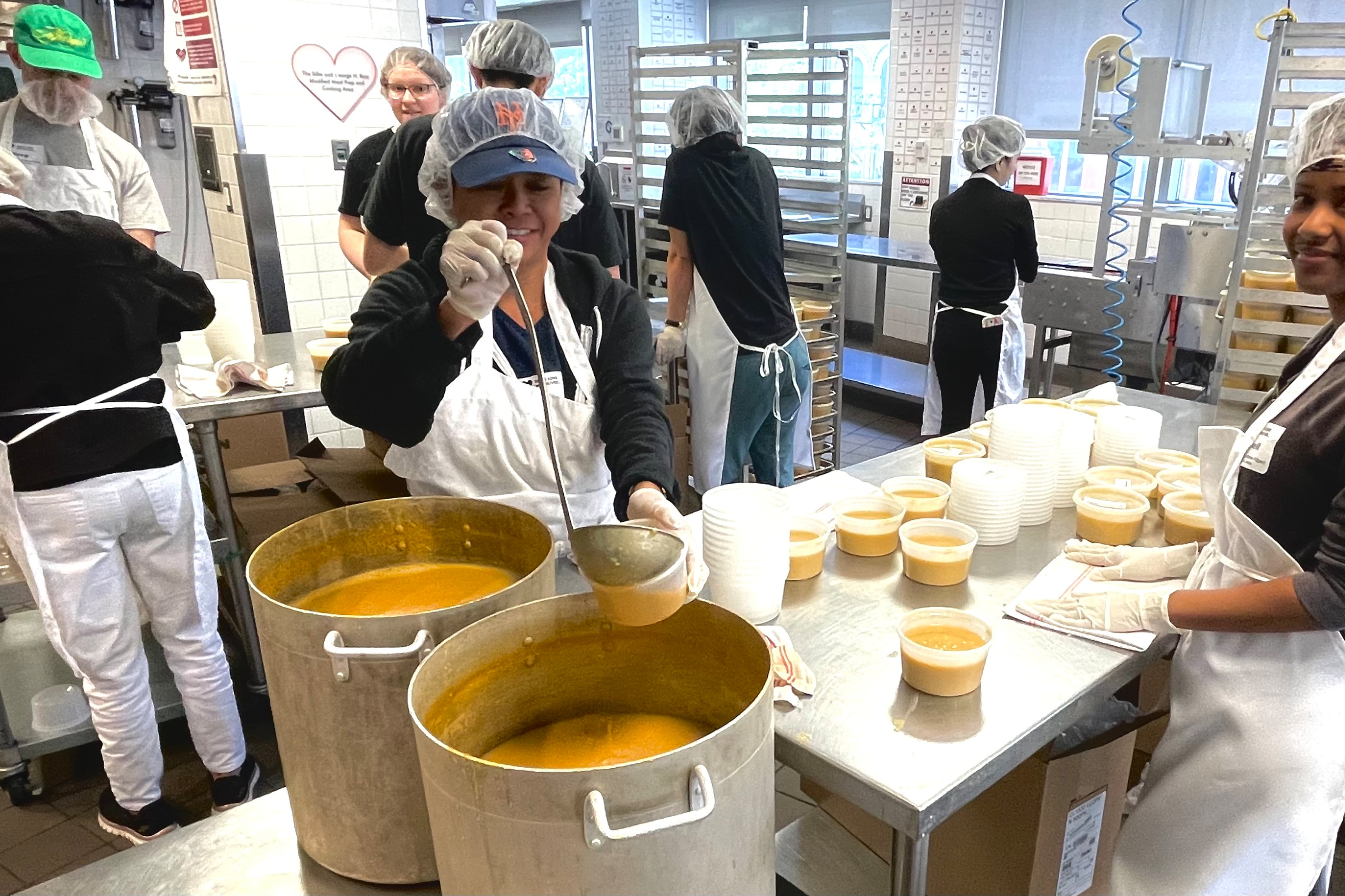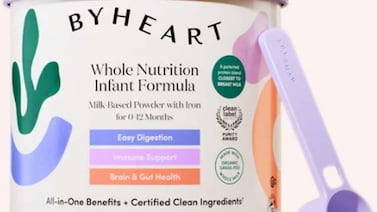Public health, explained: Sign up to receive Healthbeat’s free New York City newsletter here.
At a lower west side commercial kitchen nestled underneath rooftop greenery, about 70 meal prep volunteers, dressed in white aprons and clear bouffant caps, move in a tireless flow, ladling soup into plastic containers as chefs oversee massive steam kettles bubbling with broths for the punctual production of medically tailored meals to be delivered across New York City’s five boroughs.
These helpers are from God’s Love We Deliver, a nonprofit that pioneered the use of food as a health intervention during the AIDS crisis. At a time when traditional health services often overlooked nutrition, they stepped in to provide medically tailored meals — designed by registered dietitians — for HIV patients who were too weak or bedridden to cook for themselves.
In 2020, Amida Care became the first Medicaid Special Needs Health Plan in New York to partner with GLWD to offer medically tailored, home-delivered meals as a reimbursable benefit. This initiative aimed to support members living with complex conditions such as HIV/AIDS, diabetes, cancer, and heart failure, particularly those facing challenges in preparing meals due to their chronic health conditions.
“We’ve started seeing ourselves as a health care provider — very similar to the doctor you go to,” said Allyson Schiff, director of business development and community partnerships at GLWD. “Except instead of a prescription for a pill or physical therapy, we’re writing you a prescription for food.”
The New York State Department of Health has launched a $500 million Social Care Network to connect Medicaid members across all health plans with community-based organizations that address social determinants of health — such as food insecurity, housing instability, and transportation. This New York health initiative positions food and nutrition, often referred to as “Food as Medicine,” as essential health supports beyond the traditional clinical setting, and recognizes that medical care can happen in the community, too.
Food as Medicine programs can reduce health care costs
At the core of this network is the delivery of wraparound services — especially nutritional interventions like medically tailored meals — through trusted community-based organizations. All Medicaid members are eligible for screening and navigation to programs like SNAP, the Supplemental Nutrition Assistance Program formerly known as food stamps, and WIC, a nutrition program for women, infants, and children.
But those who meet enhanced eligibility criteria — such as people with cancer, serious mental illness, substance use disorder, or who are pregnant or postpartum — may receive direct services, including medically tailored meals, pantry restocking, nutrition education, housing support, and transportation to health-related appointments. These time-limited benefits are meant to fill critical gaps and complement, rather than duplicate, other supports.
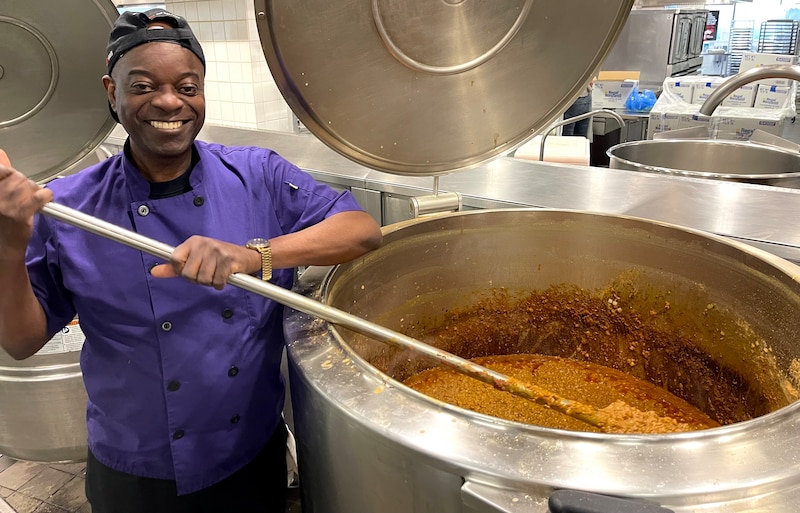
The growth of Food as Medicine initiatives in New York has been driven not only by improved health outcomes, but also by their potential to reduce health care costs. The NY Food as Medicine Coalition — which includes organizations like GLWD, the Food Pantries for the Capital District, and the Alliance for a Hunger-Free New York — has been a key advocate for integrating medically tailored meals and nutrition services into Medicaid.
Their efforts helped lay the groundwork for New York’s Social Care Network. According to the Rockefeller Foundation, a New York-based philanthropy, diet-related diseases cost the U.S. health care system an estimated $1.1 trillion annually, and scaling Food as Medicine programs nationwide could yield $13.6 billion in annual health care savings.
“Growing awareness of the link between diet and disease, the impact of nutrition on health outcomes, and the health care costs associated with chronic disease have led to increased support for Food as Medicine initiatives and efforts to incorporate them into state policy,” said Rebecca Keister, director of development and communications at Food Pantries for the Capital District.
How medically tailored meals fill gaps in care
The Social Care Network is led by nine nonprofit organizations that partner with community-based organizations to advance health equity. At GLWD, clients receive medically tailored meals developed by in-house chefs and nutritionists, who can remove components like liquids, phosphorus, and potassium for patients with renal disease.
Meal options can be made soft, minced, or pureed, ensuring clients with chewing or swallowing difficulties — like cancer patients who find foods such as chicken legs challenging — still receive vital nutrition, Schiff said. These adaptations also allow GLWD to serve children as young as 2, including those with conditions like sickle cell disease.
GLWD provides services without income requirements, and clients do not need to be on Medicaid. To qualify, clients must have a confirmed diagnosis from a doctor, nurse practitioner, or physician assistant, and experience limitations in activities of daily living, such as being unable to shop, stand, or cook due to illness or disability.
GLWD can meet the clinical needs of clients of over 200 diagnoses and delivers 4.2 million heart-healthy, low-sodium, and diabetes-friendly meals annually across all five boroughs and nearby counties with twice-weekly service. Currently, 40% to 50% of the organization’s funding comes through health care reimbursements, Schiff said.
“Medically tailored meals don’t just fill plates — they fill gaps in care. By addressing nutrition as a critical part of health, we help people manage chronic conditions, stay out of the hospital, and live healthier, more independent lives,” Schiff said.
The U.S. Department of Agriculture reports people who are food insecure — lacking access to the necessary foods to meet their nutritional needs — are at a greater risk of developing 10 of the costliest and most deadly diet-related chronic conditions, including hypertension, coronary heart disease, stroke, cancer, and diabetes.
According to the Community Service Society of New York’s 2024 Annual Survey of Housing and Economic Security, even earning three times the federal poverty threshold of $15,650 a year for a single person ($46,950) doesn’t insulate New Yorkers from food insecurity. And having a full-time job is no safeguard either — nearly 1 in 5 full-time workers surveyed still said they struggled to afford enough food. New York has the highest income inequality of any state in the United States, according to data from the U.S. Census Bureau published in 2023.
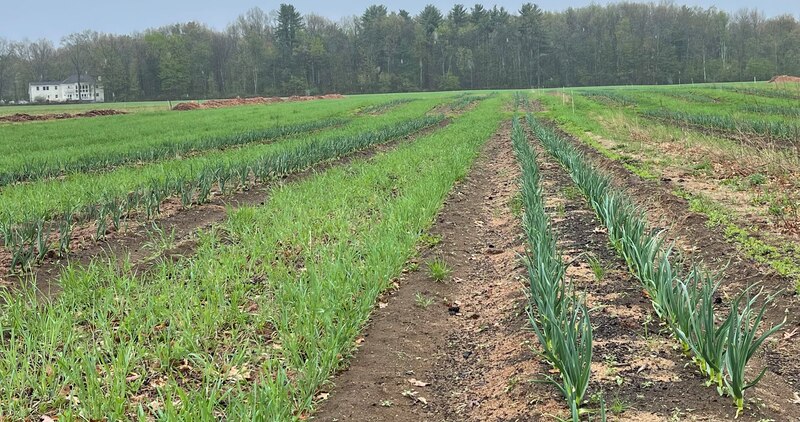
Food sovereignty: Some projects work with local farms
Several nonprofits across New York are going a step beyond individualized meals and are embracing food sovereignty, prioritizing community control over food systems through grassroots Food as Medicine initiatives.
Pitney Meadows Community Farm in Saratoga Springs has launched a pilot program in collaboration with Saratoga Hospital’s Community Health Center, supported by Health Care Without Harm. This initiative delivers biweekly boxes of fresh, locally grown produce — such as kale, carrots, garlic, onions, sweet corn, summer squash, lettuce, tomatoes, green beans, and apples — to residents of three low-income housing communities. Most of the produce is cultivated on-site at Pitney Meadows, with additional items sourced from nearby farms.
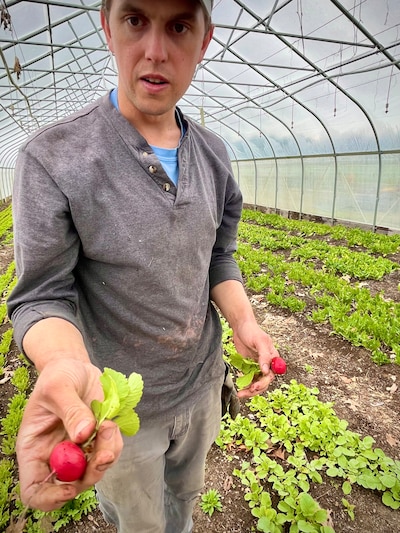
Hospital nutritionists work with the farm to develop educational materials that help participants incorporate the produce into their diets to support specific health goals. The pilot aims to evaluate how integrating fresh, local food into health care can affect health outcomes, with an eye toward expanding the model regionally.
Daniel Williams, Pitney Meadows’ food sovereignty and farm engagement coordinator, said they draw inspiration from movements in South America and Africa. These movements united to affirm Indigenous peoples’ rights to grow and eat food on their own terms, in line with their traditions and practices.
“There’s a need to have the people of our community have access to good food that’s grown, that comes from within the community, and feeds the community,” Williams said.
HHS drops waivers that funded Food as Medicine programs in New York
At the January 2024 Food Is Medicine Summit, the U.S. Department of Health and Human Services launched a national effort to expand nutrition-based interventions through Medicaid managed care and Section 1115 waivers, which let states test innovative Medicaid programs, including social care funding.
But in April, the agency reversed course, announcing it will no longer approve or renew these waivers. This threatens New York’s Health Equity Reform Waiver, which funds Social Care Networks and expires in March 2027.
For God’s Love We Deliver, this risks 40% of its funding from Medicaid reimbursements tied to regional managed care pilots, like Amida Care’s In Lieu of Services initiative, which rely on the waiver’s federal matching funds.
“Given that such a huge part of our funding comes from health care right now, what happens after 2027 when the waiver ends, is a very big question mark for us,” Schiff said. “We’re currently in the midst of strategy and planning to see how we can continue our growth and our good work in a post-waiver world.”
This story was produced in partnership with the Health & Science Reporting Program at the Craig Newmark Graduate School of Journalism at CUNY.

